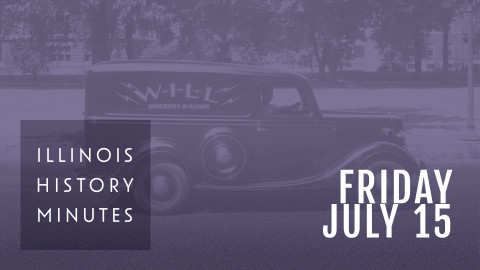
July 28 Illinois History Minute
It’s July 28th. And on this day in 1961, Governor Otto Kerner signed a major overhaul of Illinois’ criminal code … covering everything from police powers to when abortion was permitted.
As WILL-AM celebrates a century of being on the air, we are sharing a minute-long snippet of Illinois history every weekday in 2022. This daily feature includes memorable people, places and events of that helped shape the prairie state.
Hosted by Illinois Public Media reporter Jim Meadows, the minute of Illinois History will air on WILL-AM/FM at 7:42 a.m. during Morning Edition and 5:32 p.m. during All Things Considered; as well as on WILL-AM in the 1 o'clock hour of Here & Now and at 8 o'clock in the evening. We've also made them available below for all of you history buffs!

It’s July 28th. And on this day in 1961, Governor Otto Kerner signed a major overhaul of Illinois’ criminal code … covering everything from police powers to when abortion was permitted.

It’s July 27th, the day in 2004 when a state senator from Chicago named Barack Obama gave the keynote address at the Democratic National Convention in Boston that would introduce him to the nation. In addition to praising presidential nominee John Kerry, Obama chided pundits and commentators for exaggerating and exploiting America’s political divisions.

It’s July 26th, and Illinois governor Adlai Stevenson accepted his party’s nomination for president with a speech on this day at the 1952 Democratic National Convention in Chicago.

“This city is in the throes of a race war”. That was the opening sentence, as a newspaper in Evansville Indiana reported on a white mob that lynched a Black man in Danville Illinois on this day in 1903.

It’s July 22nd, and two-term Illinois governor Jim Edgar was born in Oklahoma on this day in 1946. Speaking on WILL-TV in 2013, the Republican Edgar said the key to solving Illinois’ problems was bringing opposing sides together

It’s July 21st, and writer Ernest Hemingway was born on this day in 1899 in the Chicago suburb of Oak Park. After spending time as an ambulance driver in World War One and a reporter in Toronto, Hemingway lived for a time in Chicago, where he met his first wife, Hadley Richardson. Together, they moved to Paris, and Hemingway began writing the fiction that would make him famous.

It’s July 20th, and Illinois House Speaker Louie Lewis was born on a southern Illinois farm on this day in 1893. As a candidate for lieutenant governor in 1940, Lewis countered charges of Democratic corruption with his own charges of Republican corruption.

It’s July 19th. The site across the Mississippi River from St. Louis that we call Cahokia Mounds was a pre-Columbian Native American city, believed to have been at its height around the year 1100 (eleven-hundred), with a population of ten to twenty thousand. On this day in 1965, Cahokia Mounds was designated a National Historic Landmark and placed on the National Register of Historic Places.

It’s July 18th. And on this day in 1940, the University of Illinois’ student newspaper, the Daily Illini, congratulated U of I music professor Bruce Foote for signing a contract to perform on Chicago’s WGN Radio.

It’s July 15th, and the 1940 Democratic National Convention opened on this day in Chicago, one of 11 Democratic conventions the Windy City has hosted since 1864. President Franklin Roosevelt planned to run for an unprecedented third term.
Campbell Hall
300 N. Goodwin
Urbana, IL 61801
217-333-7300